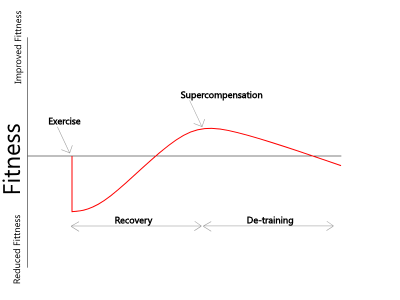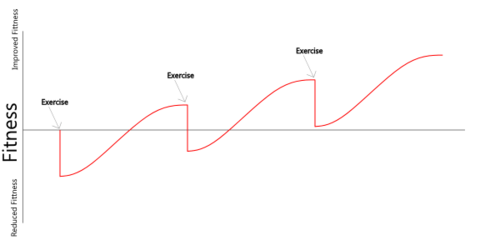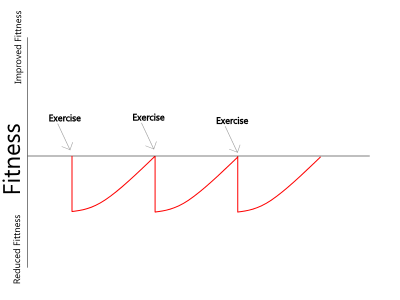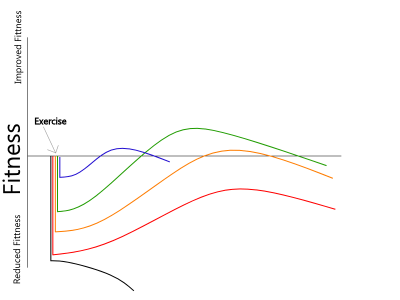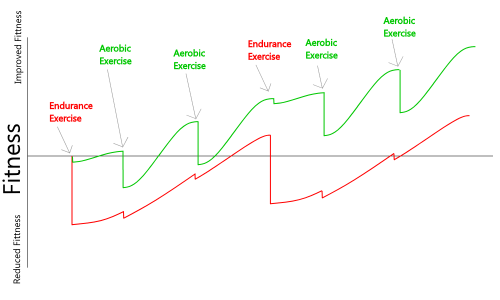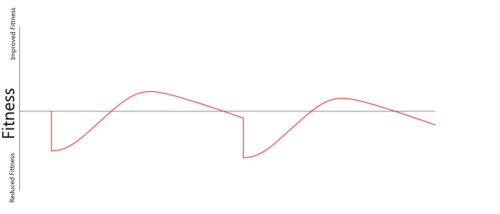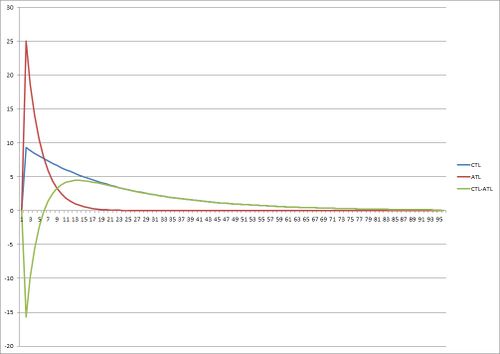Difference between revisions of "Supercompensation"
User:Fellrnr (User talk:Fellrnr | contribs) |
User:Fellrnr (User talk:Fellrnr | contribs) |
||
| (10 intermediate revisions by the same user not shown) | |||
| Line 1: | Line 1: | ||
| − | + | One of my favorite sayings is "Exercise does not make you fit; it's the rest that follows exercise that makes you fit." It's a natural human failing to assume that because exercise is critical to improved fitness it's the only thing that matters. Rest and recovery are all too often viewed as a necessary evil, or sign of weakness. Even when the importance of rest is understood intellectually, it can be hard to internalize this idea. There are two practical steps you can take to optimize your Supercompensation: | |
| − | + | * '''Hard/easy days'''. It's been suggested that the biggest problem that recreational athletes have is that they train too hard on the easy days. This additional exercise on what should be rest and recovery days reduces the body's ability to Supercompensation. In turn this tends to reduce the intensity that can be achieved on the hard training days. A good training program will have hard training sessions that damage the body just enough to promote Supercompensation, and rest days that provide the opportunity to recover. | |
| − | + | * '''Training Monotony'''. Probably the most overlooked training metric is that of [[Training Monotony]]. This metric is not about boredom, but a way of measuring how similar each day's training stress is. Training monotony can be calculated from your daily mileage or duration using a spreadsheet, or via my [[SportTracks Dailymile Plugin]]. I have a simple online calculator on the [[Training Monotony]] page. | |
| − | + | While Supercompensation is a useful model, the reality is a lot more complex. There are many [[Endurance Adaptations]] that occur as a response to training, and they may occur in response to different types of training stress and have varying timeframes for the Supercompensation to occur. In addition, other life stresses can contribute to [[Overtraining Syndrome]], which should probably be called "training induced clinical depression" as the term "overtraining" incorrectly implies excessive training is the problem. However, it's unclear how these life stresses might impact Supercompensation. | |
| − | [[ | + | =Modeling Supercompensation = |
| − | + | The graph below looks at how fitness changes over time in response to a single bout of exercise. You can see that the exercise initially reduces fitness, and that rest time is required to gain the benefits. | |
| − | + | [[File:Supercompensation-small.png|center|frameless|500px]] | |
| − | + | =Adequate Rest= | |
| − | + | Ideally, you will get sufficient rest so that you recover from the training stress and get the maximum benefit. This would mean starting the next training session near the peak of Supercompensation, as shown below. | |
| − | Ideally, you will get sufficient rest so that you recover from the training stress and get the maximum benefit. This would mean starting the next training session near the peak of | + | [[File:Supercompensation-continued-small.png|center|frameless|500px]] |
| − | + | =Insufficient rest resulting in stagnation= | |
| − | [[File:Supercompensation-continued-small.png]] | + | Without sufficient rest, you may start your next training at the end of the period marked 'Recovery'. This means that you have not benefited from the training, just barely recovered from it. This can carry on indefinitely, with no improvement in fitness. |
| − | + | [[File:Supercompensation-stagnation-small.png|center|frameless|500px]] | |
| − | + | =Overtraining= | |
| − | + | {{Main|Overtraining}} | |
| − | + | Without sufficient rest to recover from the training stress, the fitness level starts to decline, with each training bout further reducing fitness. Sadly, the response to this is often to increase the training stress, creating a positive feedback cycle. | |
| − | Without sufficient rest, you may start your next training at the end of the period marked | + | [[File:Supercompensation-fatigue-small.png|center|frameless|500px]] |
| − | + | =Intensity and Supercompensation= | |
| − | [[File:Supercompensation-stagnation-small.png]] | + | Different intensities produce different levels of fatigue and resulting Supercompensation. In the diagram below, the blue line shows insufficient intensity, producing only a small amount of Supercompensation. The orange line is too intense, requiring so long to recover that little Supercompensation occurs. The red line shows far too much intensity, resulting in an inability to Supercompensate. The black line shows an intensity level resulting in injury rather than Supercompensation. Thus it is important to work out the right level of intensity to produce the required level of Supercompensation. This is a 'Goldilocks' situation, where too much or too little intensity produces a negative outcome. For each individual, there is an optimum level of exercise and recovery that produces the best Supercompensation. The most common problem in highly motivated athletes is when they are working too hard with too little rest, they understand that they are not improving, but they adjust the wrong way and try to work harder. Exercise is not a situation where 'more is better'. |
| − | + | [[File:Supercompensation-Intensity-small.png|center|frameless|500px]] | |
| − | + | =Different Systems= | |
| − | == | + | The diagram below represents a personal hypothesis based on my observation that [[Long Run| long runs]] and speedwork can be combined. After a long run, it is quite practical to perform speedwork and gain benefits, when doing a long run at that point in the recovery would produce serious fatigue or injury. My hypothesis is that the long run primarily affects the endurance fitness and speedwork primarily affects aerobic fitness. Thus a long run triggers the endurance Supercompensation curve (red), but does not have much impact on the aerobic Supercompensation curve (green). Likewise, the speedwork triggers the aerobic Supercompensation curve (green), but does not have much impact on the endurance Supercompensation curve (red). In practice, things are probably a lot more complex than this, but I believe this is a useful model. (As George P. E. Box said "[[All models are wrong]], but some models are useful".) |
| − | Without | + | [[File:Supercompensation-different-systems-small.png|center|frameless|500px]] |
| − | + | =How long to rest?= | |
| − | [[File:Supercompensation-fatigue-small.png]] | + | I am a big believer in running four days a week, as it allows for tough training and good recovery. However, different levels of training stress will require different rest periods. To make matters more complex, different systems ([[Muscle| muscles]], cardiovascular, tendons, bones, hormones) are likely to require different rest for a given training stress. This means that the optimum amount of rest is likely to vary significantly. However, it is generally accepted that doing 'quality' or 'hard' workout every day is too much. The idea of alternating hard and easy days is based on the need for more than 24 hours rest. I believe it is reasonable to conclude that the 'easy' days do nothing more than interfere with the rest that is needed, and hinder fitness, rather than improving it. Hence the idea of training four days a week. |
| − | + | =Too much rest?= | |
| − | |||
| − | Different intensities produce different levels of fatigue and resulting | ||
| − | |||
| − | [[File:Supercompensation-Intensity-small.png]] | ||
| − | |||
| − | |||
| − | The diagram below represents a personal hypothesis based on my observation that long runs and speedwork can be combined. After a long run, it is quite practical to perform speedwork and gain benefits, when doing a long run at that point in the recovery would produce serious fatigue or injury. My hypothesis is that the long run primarily affects the endurance fitness and speedwork primarily affects aerobic fitness. Thus a long run triggers the endurance | ||
| − | |||
| − | [[File:Supercompensation-different-systems-small.png]] | ||
| − | |||
| − | |||
| − | I am a big believer in running four days a week, as it allows for tough training and good recovery. However, different levels of training stress will require different rest periods. To make matters more complex, different systems (muscles, cardiovascular, tendons, bones, hormones) are likely to require different rest for a given training stress. This means that the optimum amount of rest is likely to vary significantly. However, it is generally accepted that doing | ||
| − | |||
| − | |||
It is possible to get too much rest. Trying to gain fitness on one or two days training per week does not seem to work for most people. This can be shown in the image below. | It is possible to get too much rest. Trying to gain fitness on one or two days training per week does not seem to work for most people. This can be shown in the image below. | ||
| − | + | [[File:Supercompensation-toomuchrest-small.png|center|frameless|500px]] | |
| − | [[File:Supercompensation-toomuchrest-small.png]] | + | =Modeling Human Performance= |
| + | There are various ways of [[Modeling Human Performance]] that use the short and longer term effects of training to predict performance. For a single workout, they produce a similar result to Supercompensation: | ||
| + | [[File:TSB Single Workout.jpg|center|frameless|500px]] | ||
| + | [[Category:Training]] | ||
| + | [[Category:Science]] | ||
Latest revision as of 09:07, 24 December 2014
One of my favorite sayings is "Exercise does not make you fit; it's the rest that follows exercise that makes you fit." It's a natural human failing to assume that because exercise is critical to improved fitness it's the only thing that matters. Rest and recovery are all too often viewed as a necessary evil, or sign of weakness. Even when the importance of rest is understood intellectually, it can be hard to internalize this idea. There are two practical steps you can take to optimize your Supercompensation:
- Hard/easy days. It's been suggested that the biggest problem that recreational athletes have is that they train too hard on the easy days. This additional exercise on what should be rest and recovery days reduces the body's ability to Supercompensation. In turn this tends to reduce the intensity that can be achieved on the hard training days. A good training program will have hard training sessions that damage the body just enough to promote Supercompensation, and rest days that provide the opportunity to recover.
- Training Monotony. Probably the most overlooked training metric is that of Training Monotony. This metric is not about boredom, but a way of measuring how similar each day's training stress is. Training monotony can be calculated from your daily mileage or duration using a spreadsheet, or via my SportTracks Dailymile Plugin. I have a simple online calculator on the Training Monotony page.
While Supercompensation is a useful model, the reality is a lot more complex. There are many Endurance Adaptations that occur as a response to training, and they may occur in response to different types of training stress and have varying timeframes for the Supercompensation to occur. In addition, other life stresses can contribute to Overtraining Syndrome, which should probably be called "training induced clinical depression" as the term "overtraining" incorrectly implies excessive training is the problem. However, it's unclear how these life stresses might impact Supercompensation.
Contents
1 Modeling Supercompensation
The graph below looks at how fitness changes over time in response to a single bout of exercise. You can see that the exercise initially reduces fitness, and that rest time is required to gain the benefits.
2 Adequate Rest
Ideally, you will get sufficient rest so that you recover from the training stress and get the maximum benefit. This would mean starting the next training session near the peak of Supercompensation, as shown below.
3 Insufficient rest resulting in stagnation
Without sufficient rest, you may start your next training at the end of the period marked 'Recovery'. This means that you have not benefited from the training, just barely recovered from it. This can carry on indefinitely, with no improvement in fitness.
4 Overtraining
Main article: Overtraining
Without sufficient rest to recover from the training stress, the fitness level starts to decline, with each training bout further reducing fitness. Sadly, the response to this is often to increase the training stress, creating a positive feedback cycle.
5 Intensity and Supercompensation
Different intensities produce different levels of fatigue and resulting Supercompensation. In the diagram below, the blue line shows insufficient intensity, producing only a small amount of Supercompensation. The orange line is too intense, requiring so long to recover that little Supercompensation occurs. The red line shows far too much intensity, resulting in an inability to Supercompensate. The black line shows an intensity level resulting in injury rather than Supercompensation. Thus it is important to work out the right level of intensity to produce the required level of Supercompensation. This is a 'Goldilocks' situation, where too much or too little intensity produces a negative outcome. For each individual, there is an optimum level of exercise and recovery that produces the best Supercompensation. The most common problem in highly motivated athletes is when they are working too hard with too little rest, they understand that they are not improving, but they adjust the wrong way and try to work harder. Exercise is not a situation where 'more is better'.
6 Different Systems
The diagram below represents a personal hypothesis based on my observation that long runs and speedwork can be combined. After a long run, it is quite practical to perform speedwork and gain benefits, when doing a long run at that point in the recovery would produce serious fatigue or injury. My hypothesis is that the long run primarily affects the endurance fitness and speedwork primarily affects aerobic fitness. Thus a long run triggers the endurance Supercompensation curve (red), but does not have much impact on the aerobic Supercompensation curve (green). Likewise, the speedwork triggers the aerobic Supercompensation curve (green), but does not have much impact on the endurance Supercompensation curve (red). In practice, things are probably a lot more complex than this, but I believe this is a useful model. (As George P. E. Box said "All models are wrong, but some models are useful".)
7 How long to rest?
I am a big believer in running four days a week, as it allows for tough training and good recovery. However, different levels of training stress will require different rest periods. To make matters more complex, different systems ( muscles, cardiovascular, tendons, bones, hormones) are likely to require different rest for a given training stress. This means that the optimum amount of rest is likely to vary significantly. However, it is generally accepted that doing 'quality' or 'hard' workout every day is too much. The idea of alternating hard and easy days is based on the need for more than 24 hours rest. I believe it is reasonable to conclude that the 'easy' days do nothing more than interfere with the rest that is needed, and hinder fitness, rather than improving it. Hence the idea of training four days a week.
8 Too much rest?
It is possible to get too much rest. Trying to gain fitness on one or two days training per week does not seem to work for most people. This can be shown in the image below.
9 Modeling Human Performance
There are various ways of Modeling Human Performance that use the short and longer term effects of training to predict performance. For a single workout, they produce a similar result to Supercompensation:
- Category:Training
- Category:Science
